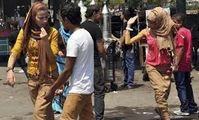Home
/ About Egypt / History of Egypt / Archaeologists: New Tomb Dating Back to 1200 BC Discovered in Egypt
Archaeologists: New Tomb Dating Back to 1200 BC Discovered in Egypt

Created: Apr 25, 2010,
modified: Jan 13, 2012,
overall rating: 0.000
Dr. Zahi Hawass, Secretary General of the Supreme Council of Antiquities, reported that this is the first Ramesside tomb to be discovered in Lower Egypt.
The tomb is very high quality, and is beautifully decorated and inscribed with scenes known from the Ramesside Period, added Dr. Hawass. In addition to this tomb, the excavation has found 35 tombs dated to the Roman Period.
The excavation discovered a limestone stela inscribed with hieroglyphs containing the name of the capital of the Hyksos, Avaris (Het-Waret). The stela depicts the god Set in front of a king of Dynasty 19, whose name is not written. This stela shows the relationship between the site at Tell el-Maskhuta and the Hyksos capital Avaris, located at Tell el-Daba in Sharqiya.
Dr. Mohamed Abdel Maqsud, the supervisor of the Department of Antiquities of Lower Egypt, said there was a large limestone sarcophagus found inside the tomb that belonged to the owner, Ken-Amun. He was the overseer of the royal records during the 19th Dynasty. The sarcophagus contained inscriptions on its inner and outer surfaces. The tomb walls were inscribed with the titles of the deceased and the name of his wife, Isis, who was a singer of the god Atum. The tomb is decorated in sunken relief with different religious and funerary scenes; the most important scenes were one from the Book of the Dead Chapter 125, as well as one of women mourning the dead. Other important scenes include a depiction of the goddess Hathor in the shape of a cow, emerging from the Delta marshes, as well as a scene of the four sons of Horus. The scenes and titles in the tomb show that Ken-Amun was an important man, who was in charge of keeping the royal records.
The discovery of this tomb will provide information about the history of the Delta and the geography of the area, as well as the relationship between this area and the eastern border of Egypt. Excavations will continue at the site, and conservation and restoration work will begin at the tomb, and the tomb and its scenes will be completely documented and registered, under the supervision of Dr. Mohamed Abdel Maqsud.
Tell el-Maskhuta is located in the Wadi Tumilat near the eastern branch of the Nile that connects with the Suez Canal. When the Suez Canal was being constructed, many sphinx statues of Ramesses II and stelae were found. It is known that the ancient city at Tell el-Maskhuta contained a settlement in the Ramesside Period with a temple for Atum. It also contained a garrison, which stored supplies to equip the ancient Egyptian army before they went east to the border on their military campaigns.
Global Arab Network
The excavation discovered a limestone stela inscribed with hieroglyphs containing the name of the capital of the Hyksos, Avaris (Het-Waret). The stela depicts the god Set in front of a king of Dynasty 19, whose name is not written. This stela shows the relationship between the site at Tell el-Maskhuta and the Hyksos capital Avaris, located at Tell el-Daba in Sharqiya.
Dr. Mohamed Abdel Maqsud, the supervisor of the Department of Antiquities of Lower Egypt, said there was a large limestone sarcophagus found inside the tomb that belonged to the owner, Ken-Amun. He was the overseer of the royal records during the 19th Dynasty. The sarcophagus contained inscriptions on its inner and outer surfaces. The tomb walls were inscribed with the titles of the deceased and the name of his wife, Isis, who was a singer of the god Atum. The tomb is decorated in sunken relief with different religious and funerary scenes; the most important scenes were one from the Book of the Dead Chapter 125, as well as one of women mourning the dead. Other important scenes include a depiction of the goddess Hathor in the shape of a cow, emerging from the Delta marshes, as well as a scene of the four sons of Horus. The scenes and titles in the tomb show that Ken-Amun was an important man, who was in charge of keeping the royal records.
The discovery of this tomb will provide information about the history of the Delta and the geography of the area, as well as the relationship between this area and the eastern border of Egypt. Excavations will continue at the site, and conservation and restoration work will begin at the tomb, and the tomb and its scenes will be completely documented and registered, under the supervision of Dr. Mohamed Abdel Maqsud.
Tell el-Maskhuta is located in the Wadi Tumilat near the eastern branch of the Nile that connects with the Suez Canal. When the Suez Canal was being constructed, many sphinx statues of Ramesses II and stelae were found. It is known that the ancient city at Tell el-Maskhuta contained a settlement in the Ramesside Period with a temple for Atum. It also contained a garrison, which stored supplies to equip the ancient Egyptian army before they went east to the border on their military campaigns.
Global Arab Network
Your Rating:
Overall rating: 0.000
Totally voted: 0
Comments
Login/Registration
Weather in:
Exchange Rates
1 USD = 16.200 LE
1 EUR = 18.040 LE
News
-
IMF loan expected next month
Apr 22, 2013, rating: 3.000, 3 votes Egypt may secure an International Monetary Fund loan agreement in about amonth, state news agency MENA reported, quoting "informed" sources ...
Egypt may secure an International Monetary Fund loan agreement in about amonth, state news agency MENA reported, quoting "informed" sources ...
-
Country's diesel reserve only enough for three days.
Feb 05, 2013, rating: 5.000, 1 votes Egypt’s strategic reserve of diesel fuel used for trucks and grouptransport vehicles can meet demand only for three days ...
Egypt’s strategic reserve of diesel fuel used for trucks and grouptransport vehicles can meet demand only for three days ...
-
Egypt received 11 million tourists in 2012 and aims to boost that number to 14 million in 2013.
Jan 22, 2013, rating: 3.000, 2 votes
Egypt received 11 million tourists in 2012 and aims to boost that number to 14 million in 2013.
-
Egypt limits travelers leaving country to US$10,000 in cash
Dec 26, 2012, rating: 3.250, 4 votes Egypt has banned travelers from carrying more than US$10,000 in foreigncurrency cash in or out of the country ...
Egypt has banned travelers from carrying more than US$10,000 in foreigncurrency cash in or out of the country ...
-
National Coalition on Climate Change for Egypt is born
Nov 30, 2012, rating: 5.000, 1 votes The global COP18 conference on climate change opens in Doha Monday.About 17,000 participants from all over the world ...
The global COP18 conference on climate change opens in Doha Monday.About 17,000 participants from all over the world ...
-
Judgment for sexual harassment
Nov 14, 2012, rating: 3.600, 5 votes A man was sentenced to two years in prison and fined LE 2,000 for sexually harassing a woman, an ...
A man was sentenced to two years in prison and fined LE 2,000 for sexually harassing a woman, an ...








